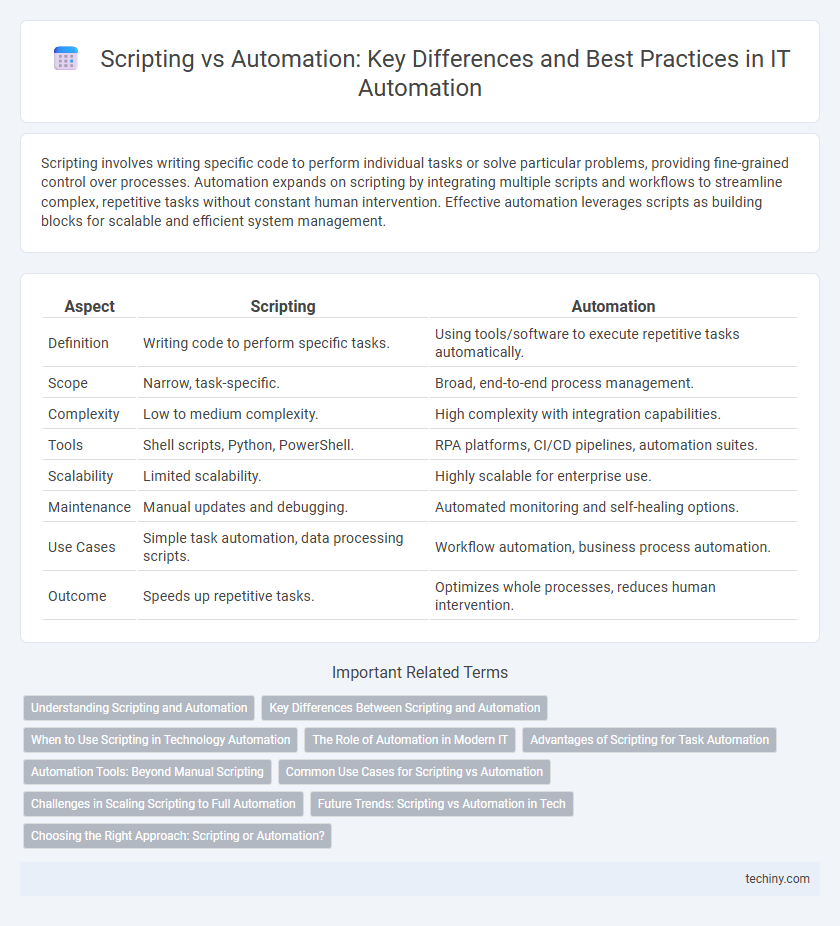Scripting involves writing specific code to perform individual tasks or solve particular problems, providing fine-grained control over processes. Automation expands on scripting by integrating multiple scripts and workflows to streamline complex, repetitive tasks without constant human intervention. Effective automation leverages scripts as building blocks for scalable and efficient system management.
Table of Comparison
| Aspect | Scripting | Automation |
|---|---|---|
| Definition | Writing code to perform specific tasks. | Using tools/software to execute repetitive tasks automatically. |
| Scope | Narrow, task-specific. | Broad, end-to-end process management. |
| Complexity | Low to medium complexity. | High complexity with integration capabilities. |
| Tools | Shell scripts, Python, PowerShell. | RPA platforms, CI/CD pipelines, automation suites. |
| Scalability | Limited scalability. | Highly scalable for enterprise use. |
| Maintenance | Manual updates and debugging. | Automated monitoring and self-healing options. |
| Use Cases | Simple task automation, data processing scripts. | Workflow automation, business process automation. |
| Outcome | Speeds up repetitive tasks. | Optimizes whole processes, reduces human intervention. |
Understanding Scripting and Automation
Scripting involves writing code to execute specific tasks or sequences, often automating repetitive or manual processes within a limited scope. Automation encompasses a broader approach, integrating multiple scripts, tools, and systems to streamline complex workflows and improve efficiency across an organization. Understanding scripting is essential for developing automation solutions that reduce human intervention and enhance operational accuracy.
Key Differences Between Scripting and Automation
Scripting involves writing code to perform specific tasks or sequences within a defined environment, often requiring manual execution or triggering. Automation encompasses broader system integration and orchestration, enabling repetitive processes to run independently without human intervention. Key differences include scalability, with automation supporting complex workflows across multiple systems, while scripting generally addresses isolated, task-specific needs.
When to Use Scripting in Technology Automation
Scripting is best used in technology automation for repetitive, smaller-scale tasks requiring quick, customizable solutions such as file manipulation, data extraction, or configuration changes. It excels when tasks demand flexibility and rapid deployment without the overhead of full automation frameworks. Employ scripting to streamline workflows where granular control and immediate execution are essential, especially in system administration and software development environments.
The Role of Automation in Modern IT
Automation in modern IT revolutionizes system management by reducing manual scripting tasks and enabling scalable, repeatable workflows through tools like Ansible and Puppet. It streamlines processes such as deployment, monitoring, and incident response, boosting efficiency and minimizing human error. By leveraging automation platforms, IT teams achieve faster provisioning and consistent configuration management across diverse environments.
Advantages of Scripting for Task Automation
Scripting enables precise control over repetitive tasks, allowing users to customize workflows with specific commands tailored to unique requirements. It enhances efficiency by automating routine processes without the need for complex software, thereby reducing manual errors and saving time. Scripts are highly adaptable, supporting quick modifications and integrations with various tools, making them ideal for dynamic automation environments.
Automation Tools: Beyond Manual Scripting
Automation tools extend beyond traditional manual scripting by offering user-friendly interfaces, pre-built connectors, and scalable workflows that streamline complex processes without deep coding knowledge. These platforms leverage drag-and-drop functionality, AI integration, and real-time monitoring to enhance efficiency and reduce human error. Popular automation tools such as UiPath, Power Automate, and Automation Anywhere enable businesses to automate repetitive tasks rapidly and adapt workflows dynamically.
Common Use Cases for Scripting vs Automation
Scripting is commonly used for automating repetitive tasks such as file management, data manipulation, and system monitoring, enabling quick solutions with lightweight code. Automation extends beyond scripting by integrating complex workflows across multiple systems, including CI/CD pipelines, infrastructure provisioning, and enterprise application orchestration. Both approaches optimize efficiency, but automation addresses broader, scalable processes while scripting focuses on specific, task-level automation.
Challenges in Scaling Scripting to Full Automation
Scaling scripting to full automation faces challenges such as limited reusability and maintainability of ad hoc scripts, which often lack modular design and error handling. Scripts typically cater to specific tasks, making integration into broader automated workflows complex and prone to failures. Efficiently overcoming these hurdles requires transitioning to standardized automation frameworks that support scalability, monitoring, and consistent execution.
Future Trends: Scripting vs Automation in Tech
Scripting remains essential for customizing specific tasks and automating repetitive processes within software development and IT operations. Automation platforms are increasingly integrating AI and machine learning to enable predictive maintenance, real-time decision-making, and end-to-end workflows without manual intervention. Future trends point towards a convergence where scripting skills augment automation capabilities, driving smarter, faster, and more scalable technology solutions.
Choosing the Right Approach: Scripting or Automation?
Choosing between scripting and automation depends on the complexity and scalability of the task. Scripting is ideal for simple, repetitive tasks requiring quick solutions, while automation offers robust, scalable workflows for complex processes across multiple systems. Evaluating factors like task frequency, integration needs, and long-term maintenance helps determine the most effective approach.
Scripting vs Automation Infographic

 techiny.com
techiny.com